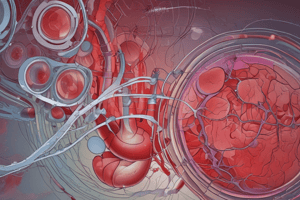Podcast
Questions and Answers
What is acid-base balance?
What is acid-base balance?
The physiological process that maintains the appropriate balance between acids and bases in the body's fluids.
What is the normal pH range indicative of acid-base balance?
What is the normal pH range indicative of acid-base balance?
- 6.8-7.2
- 7.35-7.45 (correct)
- 7.45-7.55
- 7.0-7.4
Acidosis occurs when the blood pH is above 7.45.
Acidosis occurs when the blood pH is above 7.45.
False (B)
Which system is responsible for regulating acid-base balance through the excretion or reabsorption of hydrogen ions?
Which system is responsible for regulating acid-base balance through the excretion or reabsorption of hydrogen ions?
What can cause metabolic acidosis?
What can cause metabolic acidosis?
Which of the following is a clinical manifestation of acid-base imbalances?
Which of the following is a clinical manifestation of acid-base imbalances?
What is one of the important monitoring parameters for assessing acid-base imbalances?
What is one of the important monitoring parameters for assessing acid-base imbalances?
What role do buffer systems play in acid-base regulation?
What role do buffer systems play in acid-base regulation?
Respiratory acidosis results from a build-up of CO2 due to impaired pulmonary function.
Respiratory acidosis results from a build-up of CO2 due to impaired pulmonary function.
What is the purpose of nursing interventions for acid-base imbalances?
What is the purpose of nursing interventions for acid-base imbalances?
What can be administered for acidosis?
What can be administered for acidosis?
Flashcards
Acid-Base Balance
Acid-Base Balance
Physiological process maintaining the right balance of acids and bases in body fluids for optimal cell function.
pH
pH
Measure of hydrogen ion concentration, a crucial indicator of acid-base balance.
Acidosis
Acidosis
Blood becomes too acidic (pH < 7.35), categorized as respiratory or metabolic.
Respiratory Acidosis
Respiratory Acidosis
Signup and view all the flashcards
Metabolic Acidosis
Metabolic Acidosis
Signup and view all the flashcards
Alkalosis
Alkalosis
Signup and view all the flashcards
Respiratory Alkalosis
Respiratory Alkalosis
Signup and view all the flashcards
Metabolic Alkalosis
Metabolic Alkalosis
Signup and view all the flashcards
Buffer Systems
Buffer Systems
Signup and view all the flashcards
Blood Gas Analysis
Blood Gas Analysis
Signup and view all the flashcards
Study Notes
Acid-Base Balance Fundamentals in Nursing
-
Acid-base balance is the physiological process that maintains the appropriate balance between acids and bases in the body's fluids, crucial for optimal cellular function. Imbalances can have severe consequences.
-
The body maintains this balance through intricate mechanisms involving the respiratory system, kidneys, and chemical buffers.
-
Key components include:
- pH: A measure of hydrogen ion concentration; a crucial indicator of acid-base balance. Normal range is 7.35-7.45.
- Acids: Substances that release hydrogen ions (H+) into a solution.
- Bases: Substances that accept hydrogen ions or release hydroxyl ions (OH-) into a solution.
-
Importance for Nursing Practice:
- Nurses are directly involved in monitoring and managing acid-base imbalances in patients through assessments, interventions, and patient education.
- Accurate assessment & understanding of acid-base imbalances are critical to effective nursing care and patient outcomes.
Components of Acid-Base Regulation
-
Buffer Systems: These act rapidly to resist changes in pH. Key examples include the bicarbonate buffer system (important for blood), phosphate buffer system, and protein buffer system (hemoglobin). They work by neutralizing excess acids or bases.
-
Respiratory System: Regulates acid-base balance through carbon dioxide (CO2) elimination. CO2, when dissolved in body fluids, forms carbonic acid. The lungs control CO2 levels by altering the rate and depth of respiration. Increased respiration removes more CO2, effectively reducing carbonic acid levels and raising pH. Decreased respiration leads to increased CO2 and thus lower pH.
-
Renal System: The kidneys regulate acid-base balance through the excretion or reabsorption of hydrogen ions (H+) and bicarbonate (HCO3-) ions. This process is slower than respiratory compensation but provides much greater regulatory capacity. The kidneys are critical for long-term acid-base stability.
Acid-Base Imbalances
-
Acidosis: A condition where the blood becomes too acidic (pH < 7.35). This can be classified as respiratory or metabolic, depending on the underlying cause.
- Respiratory acidosis: Results from the build-up of CO2 due to impaired pulmonary function or hypoventilation. Ex: COPD, pneumonia
- Metabolic acidosis: Is characterized by an increased acid load or loss of bicarbonate. Ex: Diabetic ketoacidosis, renal failure
-
Alkalosis: A condition where the blood becomes too alkaline (pH > 7.45). Also categorized as respiratory or metabolic.
- Respiratory alkalosis: Characterized by a decreased CO2 level resulting from hyperventilation. Ex: anxiety, high altitude
- Metabolic alkalosis: Usually caused by an excessive loss of hydrogen ions or an excess of bicarbonate. Ex: diuretic use, prolonged vomiting
Assessment & Clinical Manifestations
-
Clinical manifestations of acid-base imbalances can vary depending on the severity and the specific imbalance. They can range from mild symptoms to life-threatening complications.
-
Assessment includes evaluating patient history, vital signs, physical examination findings, and blood gas analysis.
-
Important Monitoring Parameters:
- Detailed history of past illnesses and current medications
- Vital signs: respiratory rate, heart rate, blood pressure
- Physical examination: looking for signs of dehydration, neurological changes
- Blood Gas Analysis: crucial for diagnosing and monitoring acid-base imbalances. Provides precise measurements of pH, pCO2, and HCO3-.
Nursing Interventions
-
Nursing interventions for acid-base imbalances vary depending on the cause and severity.
-
General Principles:
- Maintaining adequate respiratory function via interventions such as incentive spirometry or airway management.
- Addressing underlying causes, such as treating infections or adjusting medication regimens.
- Adequate fluid and electrolyte management to correct imbalances.
- Continuous monitoring of vital signs and blood gas values.
- Administering prescribed medications, such as bicarbonate for acidosis or potassium chloride for alkalosis.
- Educating patients and families about the disorder, treatment, and potential complications.
Critical Thinking in Nursing Practice
- Critically evaluating patient data is essential to determine appropriate interventions.
- Recognizing patterns in lab results and vital signs.
- Applying knowledge of acid-base physiology to problem-solve.
- Recognizing the importance of collaboration with other healthcare professionals in managing these conditions.
Studying That Suits You
Use AI to generate personalized quizzes and flashcards to suit your learning preferences.





